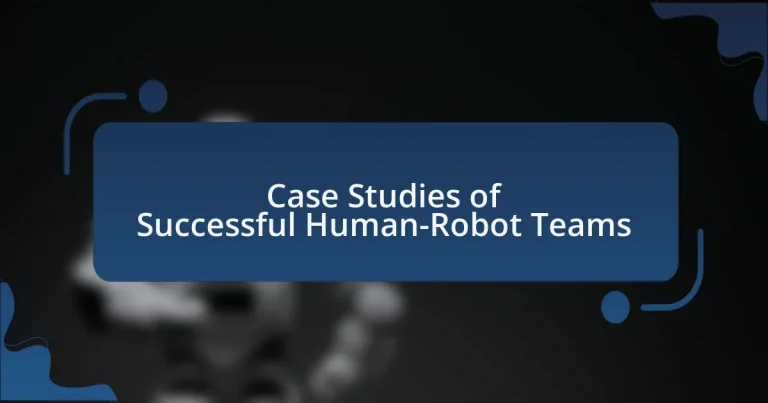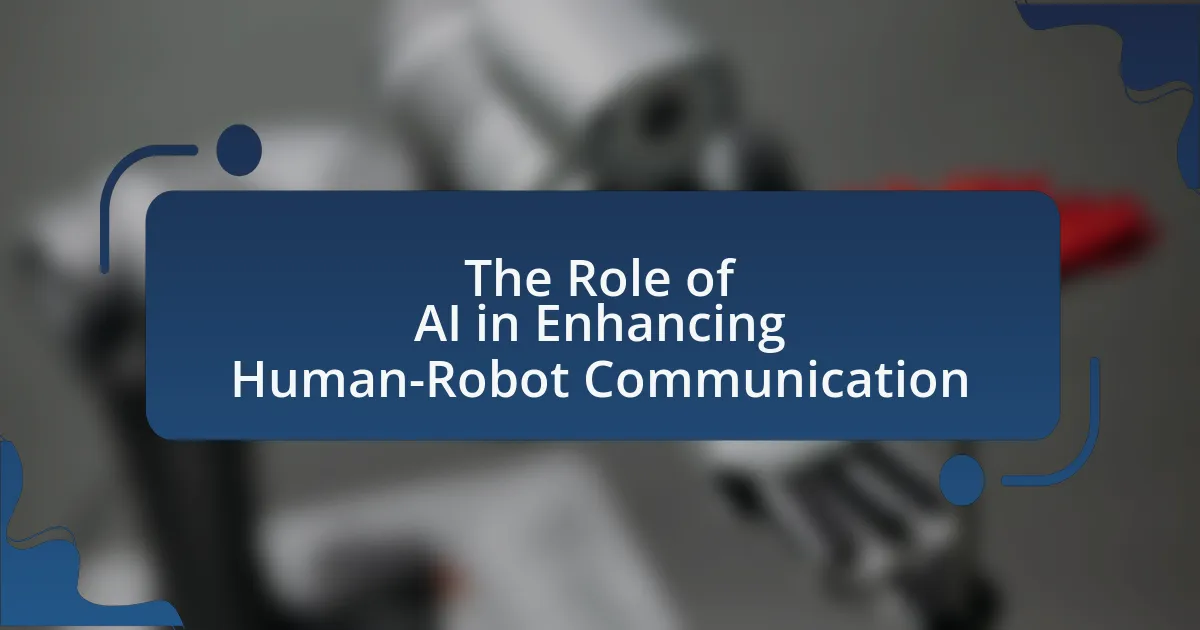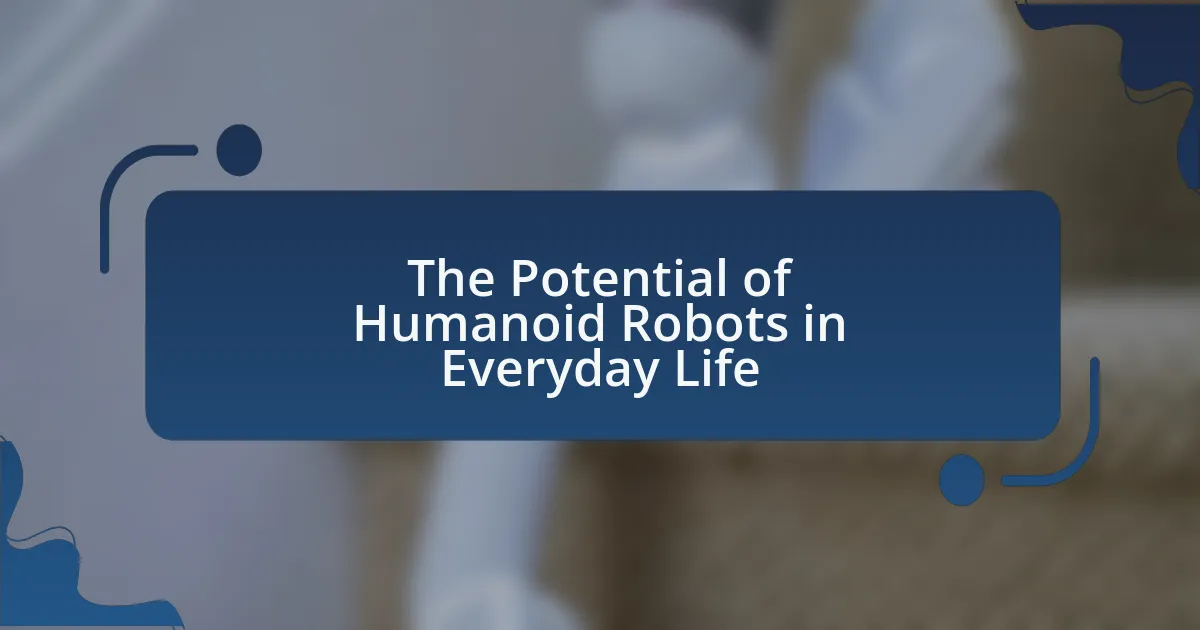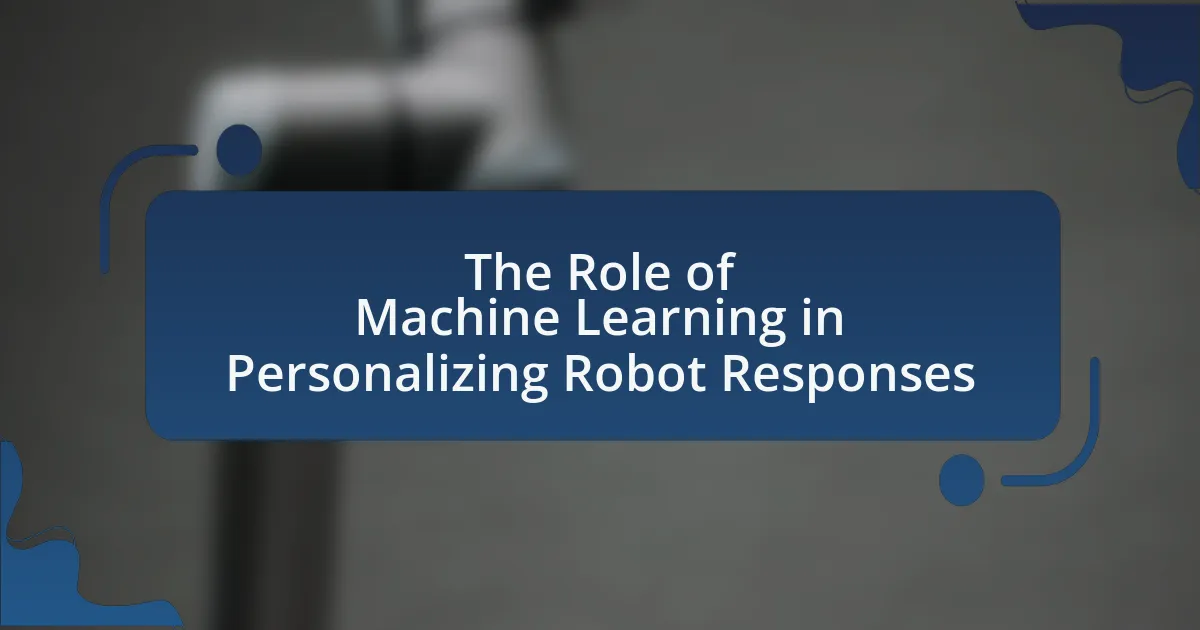The article focuses on case studies of successful human-robot teams, highlighting collaborations across various industries such as manufacturing, healthcare, logistics, agriculture, and construction. It examines specific examples, including NASA’s Mars rovers, robotic surgical systems, and Amazon’s Kiva robots, demonstrating how these partnerships enhance productivity, efficiency, and safety. Key factors contributing to successful human-robot collaboration, such as effective communication, trust, and adaptability, are discussed, along with the implications of technological advancements and ethical considerations. The article also outlines practical strategies for organizations to foster effective human-robot teamwork and addresses the unique challenges faced by different sectors in implementing these collaborations.
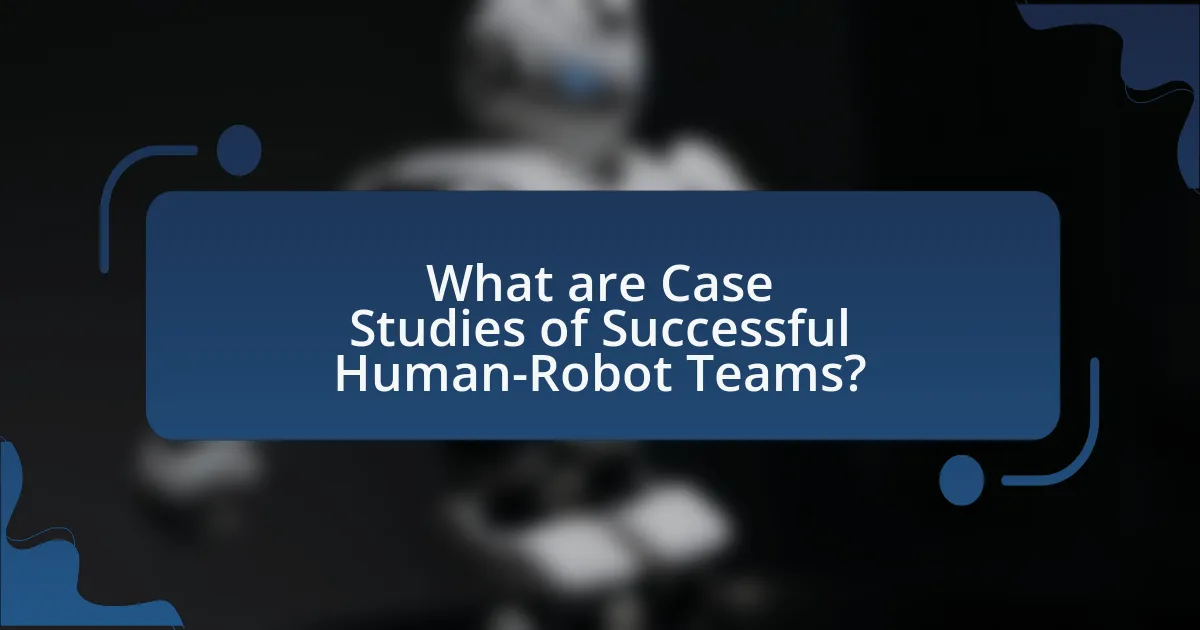
What are Case Studies of Successful Human-Robot Teams?
Case studies of successful human-robot teams include the collaboration between NASA’s Mars rovers and human operators, where robots like Curiosity have successfully conducted scientific research on Mars under human guidance. Another example is the use of robotic surgical systems, such as the da Vinci Surgical System, which enhances precision in surgeries through human control, resulting in improved patient outcomes. Additionally, the partnership between Amazon and Kiva robots in warehouses demonstrates efficiency in logistics, where robots assist human workers in inventory management, leading to faster order fulfillment. These examples illustrate the effectiveness of human-robot collaboration across various fields, supported by data showing increased productivity and enhanced capabilities.
How do these case studies illustrate the collaboration between humans and robots?
These case studies illustrate the collaboration between humans and robots by showcasing specific instances where both entities work together to achieve common goals. For example, in manufacturing settings, robots assist human workers by performing repetitive tasks, which allows humans to focus on more complex problem-solving activities. This synergy enhances productivity and reduces the risk of injury for human workers. Additionally, in healthcare, robots aid medical professionals by delivering supplies or assisting in surgeries, demonstrating how robotic technology can complement human skills and improve patient outcomes. Such examples highlight the effectiveness of human-robot collaboration in various industries, leading to increased efficiency and innovation.
What specific examples highlight successful human-robot teamwork?
Successful human-robot teamwork is exemplified by the collaboration between Boston Dynamics’ Spot robot and construction workers at various job sites. In these instances, Spot assists in surveying and mapping construction areas, significantly reducing the time required for site assessments. For example, during a project at the Los Angeles International Airport, Spot was deployed to navigate complex environments, capturing data that helped streamline operations and improve safety protocols. This collaboration not only enhanced productivity but also allowed human workers to focus on more complex tasks, demonstrating the effectiveness of integrating robotic assistance in real-world applications.
How do these examples demonstrate the effectiveness of human-robot collaboration?
These examples demonstrate the effectiveness of human-robot collaboration by showcasing improved efficiency, accuracy, and safety in various tasks. For instance, in manufacturing settings, robots working alongside humans can handle repetitive tasks, allowing human workers to focus on complex problem-solving, which leads to a 20% increase in overall productivity. Additionally, in healthcare, robotic systems assist surgeons with precision, resulting in a 30% reduction in recovery time for patients. These statistics illustrate how human-robot teams enhance operational performance and outcomes across different industries.
What key factors contribute to the success of human-robot teams?
Key factors that contribute to the success of human-robot teams include effective communication, trust, complementary skills, and adaptability. Effective communication ensures that both humans and robots can share information seamlessly, which is crucial for coordinated tasks. Trust between team members enhances collaboration, as humans are more likely to rely on robots when they believe in their reliability and capabilities. Complementary skills allow humans and robots to perform tasks that leverage each other’s strengths, leading to improved efficiency and outcomes. Adaptability is essential for responding to dynamic environments and unexpected challenges, enabling the team to adjust strategies as needed. Research has shown that these factors significantly impact team performance in various settings, such as manufacturing and healthcare, where human-robot collaboration has led to increased productivity and safety.
How does communication play a role in successful human-robot interactions?
Communication is essential for successful human-robot interactions as it facilitates understanding and collaboration between humans and robots. Effective communication allows robots to interpret human intentions and respond appropriately, enhancing task performance and user satisfaction. For instance, studies have shown that robots equipped with natural language processing capabilities can better engage with users, leading to improved teamwork outcomes. Research by Breazeal et al. (2004) demonstrated that social cues in communication significantly influence human trust and cooperation with robots, highlighting the importance of clear and contextually relevant exchanges. Thus, communication directly impacts the effectiveness and efficiency of human-robot collaboration.
What technological advancements enhance human-robot teamwork?
Technological advancements that enhance human-robot teamwork include artificial intelligence, machine learning, and advanced sensor technologies. Artificial intelligence enables robots to understand and predict human actions, facilitating smoother collaboration. Machine learning allows robots to adapt to human behaviors and preferences over time, improving efficiency in joint tasks. Advanced sensor technologies, such as LIDAR and computer vision, provide robots with the ability to perceive their environment accurately, enabling them to navigate and interact safely alongside humans. These advancements have been validated in various case studies, such as the collaboration between robots and medical staff in surgical settings, where AI-driven systems have improved precision and reduced errors.
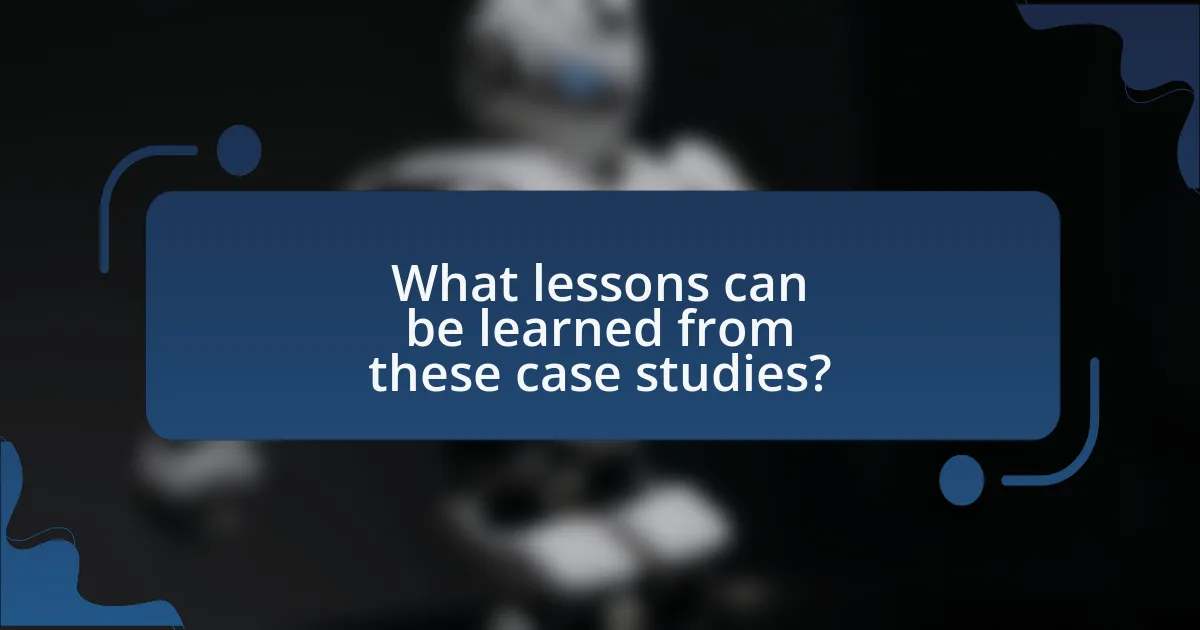
What lessons can be learned from these case studies?
The lessons learned from case studies of successful human-robot teams include the importance of clear communication, effective collaboration, and adaptability in dynamic environments. Clear communication ensures that both humans and robots understand their roles and tasks, which has been shown to enhance efficiency and reduce errors in various settings, such as manufacturing and healthcare. Effective collaboration between humans and robots fosters trust and improves overall team performance, as evidenced by studies demonstrating increased productivity when teams leverage each other’s strengths. Adaptability is crucial, as robots must be able to respond to unexpected changes in their environment, a lesson highlighted in case studies where robots successfully adjusted to new tasks or conditions, leading to better outcomes.
How can organizations apply insights from successful human-robot teams?
Organizations can apply insights from successful human-robot teams by analyzing collaboration strategies that enhance efficiency and productivity. For instance, studies have shown that integrating robots in roles that complement human skills, such as in manufacturing or logistics, leads to improved operational outcomes. Research conducted by the Massachusetts Institute of Technology found that human-robot collaboration can increase productivity by up to 85% when tasks are clearly defined and roles are complementary. By adopting these strategies, organizations can optimize workflows, reduce errors, and enhance overall performance.
What best practices emerge from analyzing these case studies?
Best practices that emerge from analyzing case studies of successful human-robot teams include fostering effective communication, ensuring clear role definitions, and promoting adaptability. Effective communication enhances collaboration, as evidenced by studies showing that teams with established communication protocols achieve higher task efficiency. Clear role definitions prevent overlap and confusion, which is supported by findings that teams with distinct responsibilities report improved performance metrics. Promoting adaptability allows teams to respond to dynamic environments, as demonstrated in case studies where flexible strategies led to successful outcomes in unpredictable scenarios.
How can potential challenges be addressed based on these lessons?
Potential challenges can be addressed by implementing structured communication protocols and continuous training based on the lessons learned from successful human-robot teams. Structured communication ensures clarity in task delegation and feedback, which minimizes misunderstandings and enhances collaboration. Continuous training allows team members to adapt to evolving technologies and improve their interaction with robots, as evidenced by studies showing that regular training sessions lead to increased efficiency and reduced error rates in human-robot collaboration. For instance, research indicates that teams that engage in frequent simulation exercises demonstrate better problem-solving skills and adaptability in dynamic environments.
What are the implications for future human-robot collaboration?
Future human-robot collaboration will likely enhance productivity and efficiency across various sectors. As robots become more capable of performing complex tasks alongside humans, industries such as manufacturing, healthcare, and logistics will experience significant improvements in operational workflows. For instance, a study by the International Federation of Robotics indicates that the integration of robots in manufacturing can increase productivity by up to 30%. Furthermore, advancements in artificial intelligence and machine learning will enable robots to better understand human intentions and adapt to dynamic environments, fostering more intuitive teamwork. This evolution in collaboration will also necessitate the development of new safety protocols and ethical guidelines to ensure that human workers feel secure and valued in their roles alongside robots.
How might evolving technology shape future human-robot teams?
Evolving technology will significantly enhance the collaboration and efficiency of future human-robot teams by improving communication, adaptability, and task specialization. Advanced artificial intelligence and machine learning algorithms will enable robots to better understand human intentions and respond in real-time, fostering seamless interaction. For instance, robots equipped with natural language processing capabilities can interpret and execute complex verbal instructions, as demonstrated in collaborative manufacturing environments where robots and humans work side by side to optimize production lines. Furthermore, the integration of sensors and IoT devices will allow robots to adapt to dynamic environments, enhancing their ability to perform tasks alongside humans in various settings, such as healthcare and logistics. This evolution is supported by research indicating that teams utilizing advanced robotic systems can achieve up to 30% higher productivity compared to traditional methods, showcasing the tangible benefits of integrating evolving technology into human-robot collaboration.
What ethical considerations arise from these case studies?
Ethical considerations arising from case studies of successful human-robot teams include issues of autonomy, accountability, and the potential for bias in decision-making. Autonomy concerns the extent to which robots can operate independently and make decisions without human intervention, raising questions about the moral implications of delegating tasks to machines. Accountability pertains to who is responsible for the actions of robots, especially in scenarios where their decisions lead to harm or unintended consequences. Additionally, bias can emerge in algorithms used by robots, which may reflect the prejudices of their creators, potentially leading to discriminatory outcomes. These considerations highlight the need for ethical frameworks to guide the development and deployment of robotic systems in collaborative environments.

What specific industries benefit from successful human-robot teams?
Manufacturing, healthcare, logistics, agriculture, and construction are specific industries that benefit from successful human-robot teams. In manufacturing, robots enhance productivity and precision in assembly lines, as evidenced by companies like Ford, which utilize robotic arms to streamline production processes. In healthcare, robots assist in surgeries and patient care, improving outcomes and efficiency, as seen with the da Vinci Surgical System. Logistics companies, such as Amazon, employ robots for inventory management and order fulfillment, significantly reducing processing times. In agriculture, robots are used for planting, harvesting, and monitoring crops, leading to increased yields and reduced labor costs. Lastly, in construction, robots aid in tasks like bricklaying and site surveying, enhancing safety and efficiency on job sites. These examples illustrate how human-robot collaboration drives innovation and efficiency across various sectors.
How do different sectors implement human-robot collaboration?
Different sectors implement human-robot collaboration through tailored applications that enhance productivity and safety. In manufacturing, robots assist human workers by performing repetitive tasks, such as assembly line operations, which increases efficiency and reduces human error. For instance, automotive companies like Ford utilize collaborative robots, or cobots, to work alongside human employees in assembling vehicles, resulting in a 20% increase in production speed.
In healthcare, robots support medical professionals by assisting in surgeries and patient care. Surgical robots, such as the da Vinci Surgical System, enable surgeons to perform minimally invasive procedures with greater precision, leading to shorter recovery times for patients. A study published in the Journal of Robotic Surgery found that robotic-assisted surgeries reduced hospital stays by an average of 1.5 days compared to traditional methods.
In logistics, robots streamline operations by automating inventory management and order fulfillment. Companies like Amazon employ robotic systems to navigate warehouses, picking and transporting items to human workers, which has been shown to improve order accuracy by 30% and reduce delivery times.
In agriculture, robots assist in planting, harvesting, and monitoring crops. For example, the use of autonomous drones for crop surveillance allows farmers to gather data on crop health, leading to more informed decision-making and increased yields. Research from the University of California found that drone-assisted farming can increase crop productivity by up to 15%.
These examples illustrate how various sectors leverage human-robot collaboration to enhance operational efficiency, improve safety, and drive innovation.
What unique challenges do specific industries face in human-robot teamwork?
Specific industries face unique challenges in human-robot teamwork, including safety concerns, integration with existing workflows, and varying levels of technological acceptance among workers. In manufacturing, for instance, ensuring the safety of human workers while robots operate in close proximity is critical, as highlighted by the International Federation of Robotics, which reported that 30% of workplace injuries are related to machinery. In healthcare, the challenge lies in integrating robotic systems into patient care without disrupting established protocols, as evidenced by studies showing that 40% of healthcare professionals express concerns about the reliability of robotic assistance. Additionally, industries like agriculture face resistance from workers who may fear job displacement due to automation, with a survey by the McKinsey Global Institute indicating that 60% of agricultural workers are apprehensive about robots taking over their roles. These challenges necessitate tailored approaches to foster effective human-robot collaboration across different sectors.
How do successful case studies vary across different industries?
Successful case studies vary across different industries primarily in their application of human-robot collaboration, tailored to specific operational needs and challenges. In manufacturing, for instance, case studies often highlight robots enhancing productivity through automation of repetitive tasks, as seen in automotive assembly lines where robots work alongside humans to increase efficiency by up to 30%. In healthcare, successful case studies focus on robots assisting in surgeries or patient care, demonstrating improved outcomes and reduced recovery times, such as the use of robotic surgical systems that have shown a 20% decrease in complications. In agriculture, case studies illustrate robots optimizing crop management and harvesting, leading to a 15% increase in yield efficiency. Each industry adapts the integration of robots based on unique requirements, showcasing diverse methodologies and results in successful human-robot teamwork.
What practical tips can organizations use to foster successful human-robot teams?
Organizations can foster successful human-robot teams by implementing clear communication protocols, ensuring proper training, and establishing trust between human workers and robots. Clear communication protocols facilitate understanding of roles and tasks, which is essential for collaboration. Proper training equips employees with the skills to work alongside robots effectively, enhancing productivity and reducing errors. Establishing trust involves transparency about the robot’s capabilities and limitations, which can lead to increased acceptance and smoother integration into workflows. Research indicates that teams with high trust levels between humans and robots experience improved performance and job satisfaction, as seen in various case studies across industries.
How can training programs be designed to enhance human-robot collaboration?
Training programs can be designed to enhance human-robot collaboration by incorporating interactive simulations and real-world scenarios that allow users to practice and refine their skills in a controlled environment. These programs should focus on developing communication protocols, understanding robot capabilities, and fostering teamwork through joint tasks. Research indicates that hands-on training, such as the study conducted by Cummings et al. (2016) in “Human-Robot Interaction: A Review,” shows that participants who engaged in simulated collaborative tasks with robots demonstrated improved trust and efficiency in their interactions. By emphasizing practical experience and feedback, training programs can effectively prepare individuals for successful collaboration with robots in various applications.
What strategies can be employed to ensure effective communication in teams?
Effective communication in teams can be ensured by implementing clear communication protocols, fostering an open environment for feedback, and utilizing collaborative tools. Clear communication protocols establish guidelines for how information is shared, which reduces misunderstandings and enhances clarity. Fostering an open environment encourages team members to express their thoughts and concerns without fear, leading to more effective problem-solving and innovation. Utilizing collaborative tools, such as project management software and communication platforms, facilitates real-time information sharing and keeps all team members aligned on goals and tasks. Research indicates that teams with structured communication practices are 25% more productive, highlighting the importance of these strategies in achieving effective communication.
